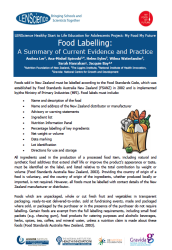Food labelling in New Zealand is determined by Food Standards Australia New Zealand (FSANZ). All ingredients used in a food product must be listed on the back of the package, along with a Nutrition Information Panel. In addition to the Nutrition Information Panel, Front of Pack Labelling provides easily-interpreted nutrition information, which could help consumers identify healthier food options. Although it is currently unknown whether front of pack labelling affects food choices and consumer purchasing behaviours, research currently being conducted at the University of Auckland is seeking to identify the most effective ways to help New Zealanders make healthier food choices.
Below is a teacher resource that outlines current and proposed food labelling practices in New Zealand and research evidence that has been used to determine policy and practice for food labelling.







